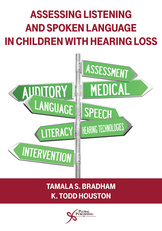Publication
Assessing Listening and Spoken Language in Children with Hearing Loss
- Edited by: Tamala S. Bradham, K Todd Houston
- Details:
- 496 pages, Illustrated (B/W), Softcover, 7 x 10"
- ISBN13:
- 978-1-59756-576-9
- Release Date:
- 12/31/2014
Overview
Assessing Listening and Spoken Language in Children with Hearing Loss is a comprehensive guide to assessments for professionals who provide intervention to infants, toddlers, preschoolers, and school-age children with hearing loss. The combined knowledge of the editors--an audiologist and a speech-language pathologist, both with 20 years of experience working with children with hearing loss and their families as well as extensive publications and presentations on the topic--brings valuable insights, experience, and research to this text.
This text provides information on assessing the whole child, what measures to consider, and how to communicate the findings. It is the distinct source for practical information on how to develop a test protocol, select appropriate tests, ensure a comprehensive assessment, and integrate the findings into an appropriate treatment plan.
As a unique resource that focuses on a relevant topic in today's accountability culture, this text will appeal to undergraduate and graduate students in deaf education and communication sciences and disorders; practicing professionals such as speech-language pathologists, audiologists, and psychologists; professionals studying for advanced certifications; as well as teachers of the deaf and hard of hearing, professors of aural (re)habilitation, special educators, school administrators, and early intervention service coordinators.
Contents
Part I. Foundations in Assessments
Chapter 1. Assessing a Child With Hearing Loss: Past, Present, and Future
- Tamala S. Bradham, K. Todd Houston, and Allan O. Diefendorf
Chapter 2. Assessment Tools: Evaluating Our Measurements
- Stephen Camarata, Hope Lancaster, and Dana Kan
Part II. Assessments
Chapter 3. Medical Assessment
- Pon Trairatvorakul and Susan Wiley
Chapter 4. Auditory Assessments
- Allan O. Diefendorf, Donna Fisher Smiley, and Tamala S. Bradham
Chapter 5. Speech Production Assessment
- Marietta M. Paterson and Christina Barris Perigoe
Chapter 6. Language Assessment of Children With Hearing Loss
- Hannah Eskridge and Kathryn Wilson
Chapter 7. Psychoeducational Assessment
- Susan Randich
Chapter 8. Literacy Assessment
- Krystal L. Werfel
Chapter 9. Assessment of the Listening Environment
- Carrie Spangler and Carol Flexer
Chapter 10. Hearing Aid Assessment
- Ryan McCreery
Chapter 11. Cochlear Implant Assessment
- Tamala S. Bradham and K. Todd Houston
Part III. Beyond the Assessments: Components to Consider
Chapter 12. Supporting Families Through the Assessment Process and Beyond
- Joni Alberg, Janet DesGeorges, Patti Martin, and Tamala S. Bradham
Chapter 13. Assessment Considerations for Children With Hearing Loss Who Are Culturally and Linguistically Diverse
- Michael Douglas
Chapter 14. From Assessment to Intervention
- K. Todd Houston, Tamala S. Bradham, and Andrea Bell
Appendix A. OPTIONSchools: Assessment Reference Guide (2014)
Appendix B. Resources
About The Editors
Tamala S. Bradham, PhD, CCC-A, is a quality consultant in the Center for Quality, Safety & Risk Prevention at Vanderbilt University Medical Center, where she is at the forefront of healthcare reform, evidence-based practices, and population health and practice management.
K. Todd Houston, PhD, CCC-SLP, LSLS Cert. AVT, is a professor in the School of Speech-Language Pathology and Audiology at The University of Akron. His primary areas of research include spoken language acquisition in children with hearing loss, enhancing parent engagement in the intervention process, Auditory-Verbal Therapy, cochlear implantation in children and adults, adult aural rehabilitation, the use of social media and social networking to support clinical services, and telepractice.
Related Titles
Comprehensive Handbook of Pediatric Audiology
Edited by: Anne Marie Tharpe, Richard Seewald
1003 pages, Illustrated (B/W), Hardcover, 8.5 x 11"
Deaf Culture
Irene W. Leigh, Jean F. Andrews, Raychelle L. Harris
318 pages, Illustrated (B/W), Softcover, 7 x 10"
Auditory-Verbal Therapy
Warren Estabrooks, Karen MacIver-Lux, Ellen A. Rhoades
602 pages, Illustrated (B/W), Hardcover, 7 x 10"
Cochlear Implants
Edited by: Betty Loy, Peter Roland
200 pages, Illustrated (B/W), Softcover, 6 x 9"
School Professionals Working with Children with Cochlear Implants
Patricia M. Chute, Mary Ellen Nevins
239 pages, Illustrated (B/W), Softcover, 6 x 9"
Cochlear Implant Patient Assessment
160 pages, Illustrated (B/W), Softcover, 8.5 x 11"
Assessment and Management of Central Auditory Processing Disorders in the Educational Setting
532 pages, Illustrated (B/W), Softcover, 7 x 10"
Literacy and Deafness
400 pages, Illustrated (B/W), Softcover, 6 x 9"
Telepractice in Speech-Language Pathology
392 pages, Illustrated (B/W), Softcover, 6 x 9"
Hearing Assistive and Access Technology
Samuel R. Atcherson, Clifford A. Franklin, Laura Smith-Olinde
320 pages, Illustrated (B/W), Softcover, 7 x 10"
Children With Hearing Loss
Elizabeth B. Cole, Carol Flexer
486 pages, Illustrated (B/W), Softcover, 6 x 9"
Auditory Perception Test for the Hearing Impaired (APT/HI)
Color Illustrations (4 Color), Spiral Bound, 8.5 x 11"
Telepractice in Audiology
Edited by: Emma Rushbrooke, K Todd Houston
284 pages, Illustrated (B/W), Softcover, 6 x 9"






















